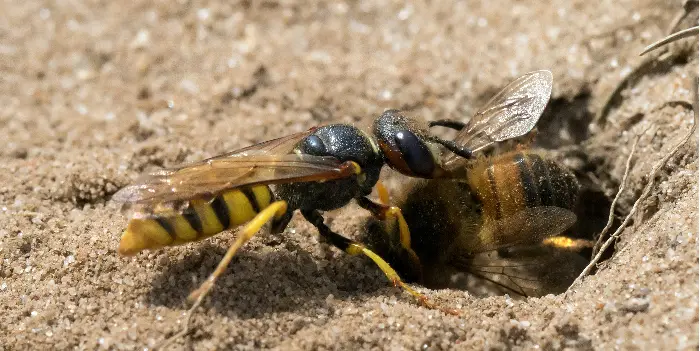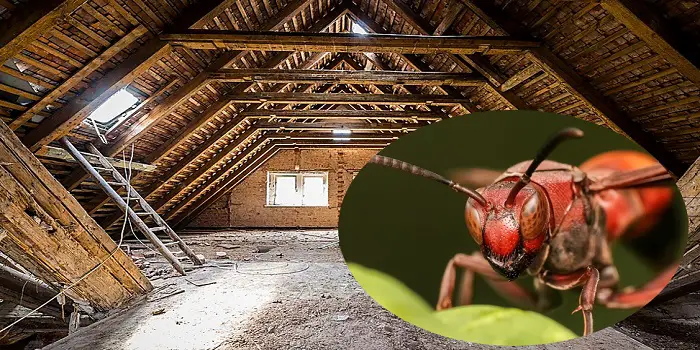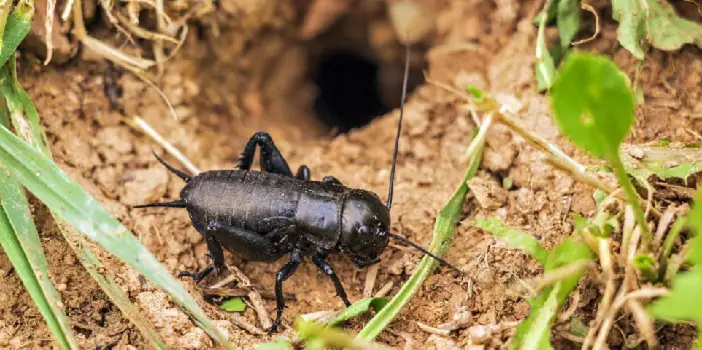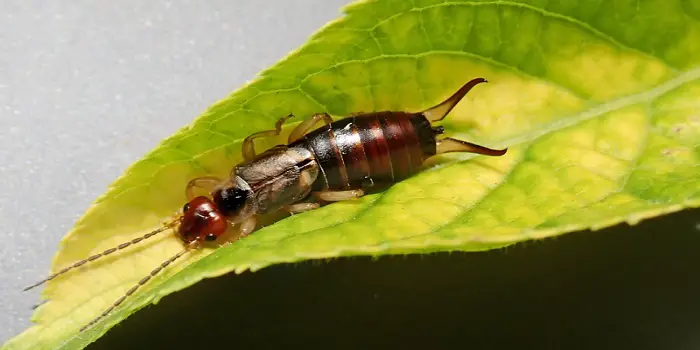
When we spend so much time and effort taking care of something, we want it to look beautiful.
The yards and gardens in our home bring us joy, but that can be taken away when pests invade.
These pests can often cause extensive damage that can be challenging to reverse.
Earwigs are one such pest that can damage your vegetable garden or your garden.
Don’t worry.
Even if such a problem exists, you can take care of it, and here are the many ways how…
But before we move to how you can eliminate earwigs, you need to understand the kind of pests they are.
What are Earwigs?
Earwigs (also called “pincher bugs”) are ancient bugs that have been around for more than two hundred million years.
There are over two-thousand species of this insect, and you can find them in any growing zone.
They look like reddish-brown insects with appendages on their tail ends (much like forceps).
They can run very quickly and can also fly often.
These insects are called earwigs because people first thought they liked to reside in human ears.
However, that is not true because the yard or garden is the one true abode they like to reside in.
The challenging part of getting rid of them is that you will never find them in the day.
They are nocturnal insects, so they hide somewhere during the day and come out at night to ruin your yard.
They wreak havoc on crops and plants, and you don’t want them anywhere in your garden.
Indoors they can hide underneath pots and eat flowers during the night.
5 Ways to Keep Earwigs Away
Once these long skinny black bug insects have found shelter in your yard or garden, they can destroy all crops.
Tender parts of the young plants are their main target; getting rid of them can be challenging and time-consuming.
However, it is not impossible, as they can be easily spotted at night with a flashlight.
With these natural preventative ways, you can eliminate earwigs and many other pests on your property.
1. Fix the Leakage
Bugs like earwigs love two things: moisture and darkness.
They love to hide in such places, so you should look in such places first.
If you leave hoses in your garden or yard, they may leak and create a damp area in the mulch for the bug to reside.
Always maintain your hoses and keep a check from time to time.
If the hoses leak on the mulch, they can be incredibly attractive to bugs.
So, ensure that you replace the gaskets of your hoses from time to time.
If the problem persists, you can purchase a new hose as they are affordable and readily available.
2. Control Plant Growth
If you are maintaining or vegetable garden or a beautiful yard with flowers, plants, and hedges, you need to maintain it.
Don’t let the plants grow too much, and regularly trim them.
Too many plants and flowers can be a perfect dark spot for the earwig to hide in.
The best way to tackle plant growth is to maintain a healthy distance between your hedges, flowers, vegetables, and walls.
That will allow everything to grow in its designated place without creating blind spots for you.
One other thing you can also do is to grow plants and flowers that pincher bugs don’t like.
The most common plants that resist earwigs include bay leaves, garlic, and wormwood.
If you have a vegetable garden, you can leave some space between every vegetable row to grow a plant that they will dislike.
Doing so will deter them from hiding there and save your crops from getting ruined.
3. Attract Birds on Your Property
Attracting birds may seem like an odd solution because everyone thinks it will create more problems for them, but it is a great solution for eliminating earwigs.
It is the most natural and organic solution you can utilize.
Birds love insects and are always looking to eat them. So they can solve your pest infestation problem in no time.
All you have to do is plant some trees that birds like to come and rest there.
Once they find this shelter and your bugs as their food source, they will never leave, and you will never have bugs again.
You can plant chokecherry, cedar, oak, and many other trees.
4. Use the Power of Strong Odor
Believe it or not, earwigs, millipedes, and centipedes are sensitive to various odors.
It bothers them so much that they never set foot in that place again.
So, using this information to your advantage can be incredibly helpful in getting rid of pests.
Cayenne pepper and essential oils are your best bet in repelling bugs and household pests.
You can create a repellent spray at home to eliminate bugs. Here is what you will need:
- 1 tsp liquid dish soap
- Twenty drops of tea tree or peppermint oil
- 1 tsp cayenne pepper
- Spray bottle
Combine all these ingredients in the spray bottle, fill it with lukewarm water, and shake it well.
Spray the mixture on any plants and flowers you want the pests to stay away from.
Remember to consistently do this and spray after every few days to permanently eliminate earwigs and other pests.
Neem oil and garlic cloves can also be used to make a powerful spray for keeping these bugs away from your vegetable garden.
5. Use Petroleum Jelly to Deter Them from Plants
If the earwigs have no way to reach your flowers, plants, or crops, they will never destroy them.
To discourage them from reaching, you can apply petroleum jelly so they can slip away instead of climbing to the plant.
Take some gloves and dip a cotton swab in petroleum jelly.
After that, spread the petroleum jelly wherever you don’t want the earwigs to reach.
Keep a check after every few days and repeat if it wears off.
The stickiness will deter the insects, and they will never come again.
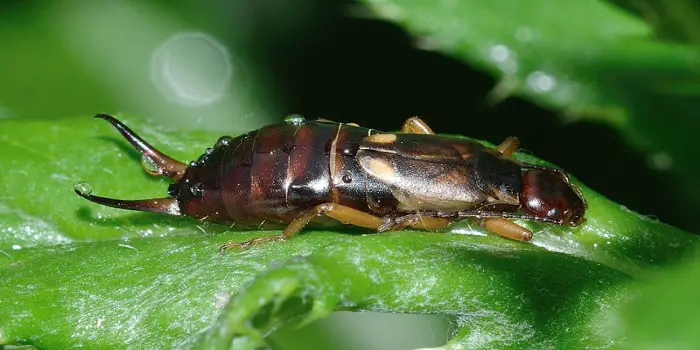
How to Trap and Kill the Pincher Bugs?
Outdoors earwigs can feed on your garden flowers and young plants, which can be annoying.
If the above measures don’t work, you will have to use a more powerful approach.
Here are five powerful ways to kill the earwigs in your garden or yard.
These ways will eliminate the problem, and your garden will remain infestation-free.
1. Create a Light Trap
Just like a moth can’t resist a flame, an earwig can’t resist light.
You can use this to your advantage by creating a trap that involves light.
They are incredibly easy to create, and they will not cause any problems in your yard or garden.
Here is what you will need to create these traps:
- Lamp
- Shallow dish
- Cold water
- 2 tsp liquid dish soap
Combine the water and the liquid soap in a shallow dish, and keep it near plants and flowers that the earwigs hide amongst.
Next to the dish, place a lamp, and light it at night.
The earwigs will not be able to resist coming near the light, and when they do, they will fall and drown in the mixture.
It is an easy way to lure the earwigs and then kill them.
You can do this for a week to eliminate all the earwigs that reside in your garden or yard.
2. Create a Sticky Trap
If the light trap isn’t enough, you can create a sticky trap to eliminate the earwigs.
Here is what you will need for such a trap:
- Small stakes
- Scissors
- Two-sided duct tape
- Cardboard
Cut a few strips of cardboard and place the two-sided duct tape on one side.
Place these sticky strips side up next to the plants.
Please make sure the stakes secure them.
However, if this doesn’t work overnight, change the tape because the dirt will not allow the earwigs to stick.
3. Use Rubbing Alcohol
Rubbing alcohol is an incredibly effective method because it instantly kills the earwigs.
So, a spray with rubbing alcohol can work wonders at eliminating earwigs from your garden.
Here is what you will need for this spray:
- Gloves
- Damp cloth
- Rubbing alcohol
- Spray bottle
- Water
Combine half water and half rubbing alcohol in the spray bottle.
Spray the mixture on the plants, leaves, or wherever you find earwigs and other bugs.
Don’t forget to wear gloves to avoid spraying your hand.
You can then wipe the plants with a damp cloth to remove the bugs.
4. Use Diatomaceous Earth
Diatomaceous earth contains microscopic shells that are incredibly sharp and can cut into insects.
Many people use this type of earth to control the pests on their property.
Sprinkle this in all the places where the pests like to reside (including cracks and crevices around baseboards, doors, and windows from where they might gain entry into your house).
It will kill them and dry them out so you can clean them later with ease.
5. Spray Boric Acid
Last but not least, you can sprinkle boric acid on the earwigs.
You can use white vinegar instead if you don’t have boric acid.
Wear gloves and spray them wherever you think there is an infestation.
However, you need to be careful with this method because it is harmful, and if you have pets, it can be a danger to their health.
So, only spray it in places that you or your pets can’t reach.
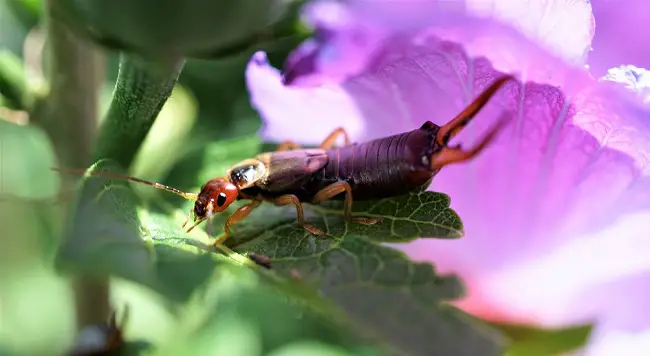
What Insecticides Can You Use for Earwigs Control?
Using Sevin (or carbaryl) insecticide is one of the best ways by which you can control severe earwig damage in your vegetable garden.
It’s safe for vegetables and is available in premixed liquid, liquid concentrates, and even in dust form.
Permethrin, Esfenvalerate, Bifenthrin, Pyrethrins, Carbaryl, Malathion, and Azadirachtin are a few other alternatives, just in case, the above pesticide is not available.
Keep in mind that not all these pesticides are recommended for crops and edible plants.
So, before using them in your vegetable garden, read the product label carefully.
It’s good to apply these insecticides late in the evening before it’s time for earwigs to come out and feed on veggies.
When applying, you should use enough water to cover the plants.
This will also help in carrying the chemicals into the top layer of soil or mulch, where the pincher bugs usually hide.
If it’s a granular pesticide or pesticide, dust is spread either by your hand or using a handheld spreader.
Few commercial earwig killers that are easily available online include:
- Delta Dust
- D-Fense SC
- Lambdastar UltraCap
- Talstar PL Granules
Talstar is a well-known brand and my top favorite as it makes earwig control quick without imposing any harm to children and pets.
The water-activated granules are easy to use and are harmless for your grass, flowers, fruits, and veggies.
Also, these are odorless and stainless.
Other Related Questions:
What do earwigs eat?
Earwigs are omnivores which means they will eat anything that is available to them in the garden.
Some of the primary things they like to feed on include animal matter and decaying plants.
They are especially fond of herbs, corn tassels, garden plants (like dahlias, marigolds, roses, and zinnias), and fruits (berries, apricots, and peaches).
With the increasing population, they may also start to feed on young foliage of vegetables and flowers along with worms, insects, aphids, maggots, and grubs.
Why do pincher bugs smell bad?
Certain earwig species are known to produce a liquid that is foul-smelling.
They usually do this for self-defensive purposes.
Few earwigs are also known to produce a pheromone (scent) which is believed to be the reason why they might be seen clustering together in large numbers.
Are earwigs’ pincers dangerous to humans?
Earwigs have a pair of intimidating pincers or “forceps” protruding from the abdomen.
This makes anyone who encounters these insects a bit concerned.
Although earwigs can pinch (and sometimes bite) humans using their pincers, the bite is not very powerful or dangerous.
Worry not; the bite of earwigs is also not poisonous as they do not have venom in their pincers.
Earwigs generally use their pincers to ward off their enemies, like birds, toads, frogs, lizards, spiders, and yellow jackets.
Also, keep a note that males will have a more developed set of larger curved pincers (or cerci) that are important for romance.
The pincers of females are generally shorter and straighter.
Final Words
That was your complete guide to getting rid of earwigs on your property.
Try a combination of these methods, and we can guarantee you that many of them will work.
Remember that you have to be consistent and keep applying these strategies because pests have a habit of showing up again.
Share the post "Getting Rid of Earwigs In Your Vegetable Garden Naturally"

Welcome to ProShieldPest.com. I am Tina Jones. I have been working as a pest removal professional in Winslow, Arizona lately. At present, I love to spend my time with my family as a retiree.
Here I share all my knowledge and experiences to help people understand better how they can stop pests at their homes without actually killing them. Hopefully, the information you will find here will help in safeguarding your home! You can check more about me here.


